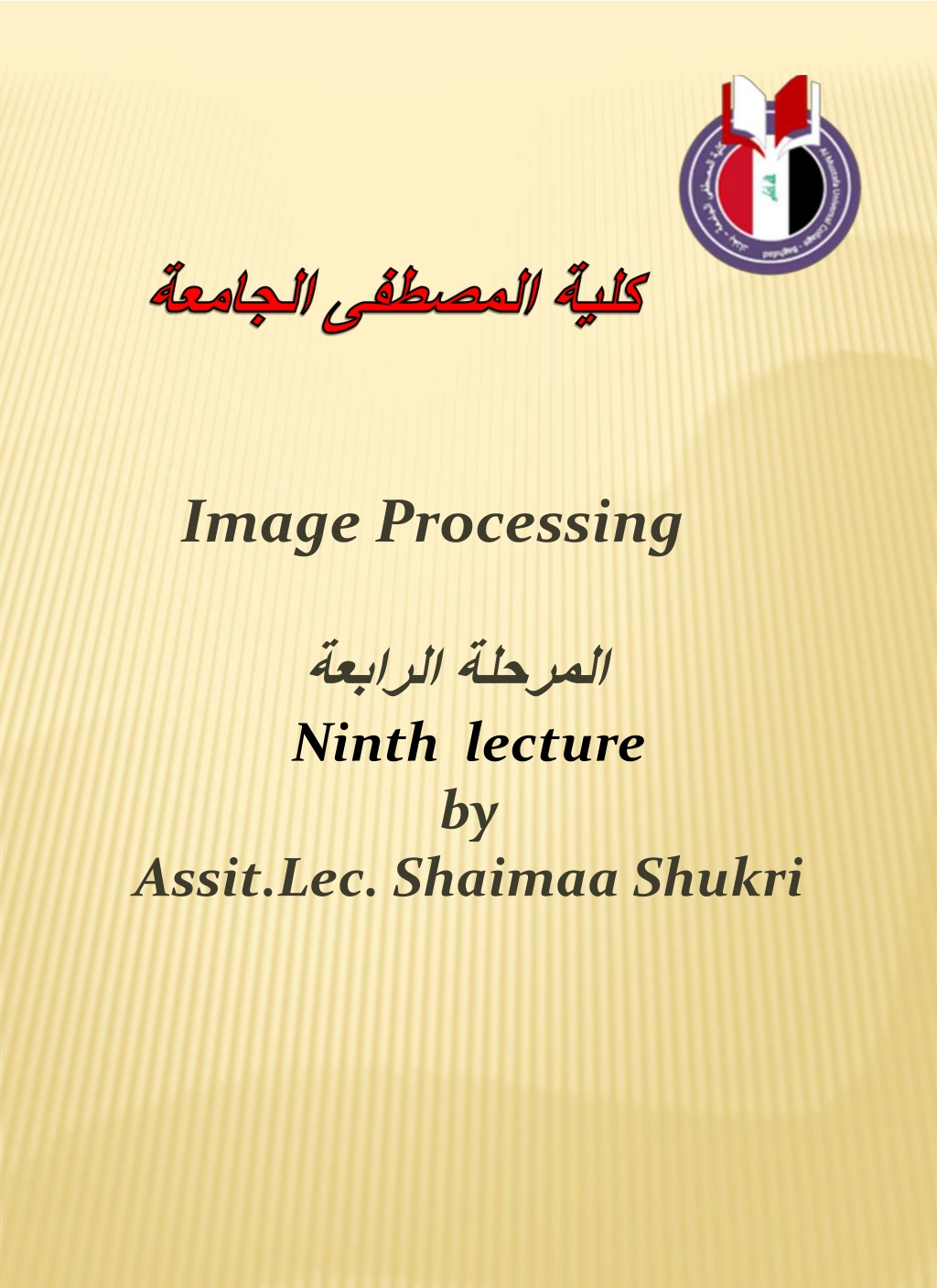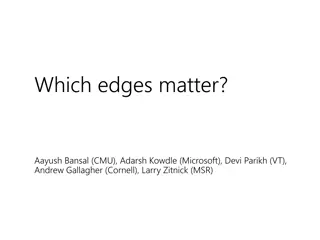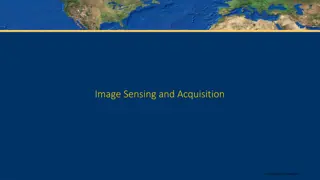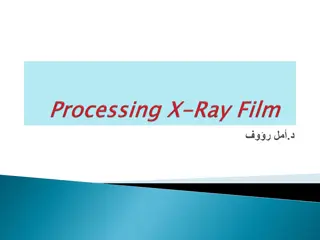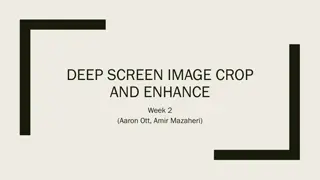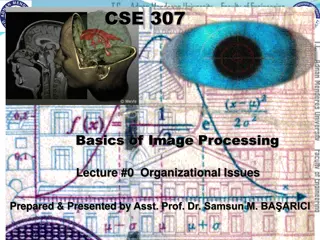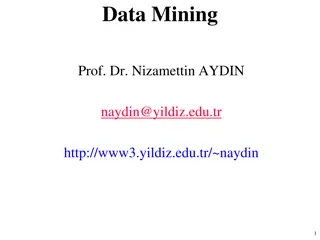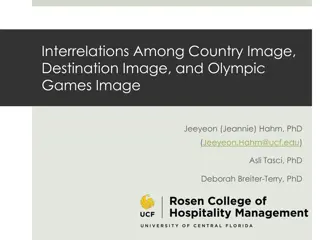Understanding Edge Detection in Image Processing
Edge detection is a fundamental operation in image processing, crucial for identifying object boundaries based on rapid changes in brightness. This process involves detecting areas of discontinuity in gray-level values to locate edges, which hold significant information about objects in an image. Convolution with masks is a common technique for calculating derivatives and amplifying edge slopes. Key principles for edge detector masks include summing to zero and approximating differentiation to enhance edge detection accuracy.
Download Presentation

Please find below an Image/Link to download the presentation.
The content on the website is provided AS IS for your information and personal use only. It may not be sold, licensed, or shared on other websites without obtaining consent from the author. Download presentation by click this link. If you encounter any issues during the download, it is possible that the publisher has removed the file from their server.
E N D
Presentation Transcript
Image Processing Ninth lecture by Assit.Lec. Shaimaa Shukri
Chapter_ Two ImageAnalysis 7. Edge Detection Detecting edges is a basic operation in image processing. The edges of items in an image hold much of the information in the image. The edges tell you where: Items are. Their size. shape and something about their texture. Edge detection methods are used as a first step in the line detection processes, and they are used to find object boundaries by marking potential edge points corresponding to place in an image where rapid changes in brightness occur. After these edge points have been marked, they can be merged to form lines and objects outlines. Edge detection operations are based on the idea that edge information in an image is found by looking at the relationship a pixel has with its neighbors. If a pixel gray_level values similar to those around it, there is probably not an edge at that point. However, if a pixel has neighbors with widely varying gray levels, it may represent an edge point. In other words, an edge is defined by a discontinuity in gray-level values. Ideally, an edge separates two distinct objects. In practice, edges are caused by: Change in color or texture or Specific lighting conditions present during the image acquisition process. The following figure illustrates the difference between an ideal edge and a real edge. 33
Chapter_Two ImageAnalysis B r i g h t e n s B r i g h t n e s a.Spatial Coordinate b.SpatialCoordinate d. Real Edge c. Ideal Edge Figure (2-19): Ideal vs. Real Edge The vertical axis represents brightness, and the horizontal axis shows the spatial coordinates. The abrupt change in brightness characterizes an ideal edge. In the figure (b) we see the representation of real edge, which change gradually. This gradual change is a minor form of blurring caused by: Imaging devices The lenses Or the lighting and it is typical for real world (as opposed to computer _generated) images. An edged is where the gray level of the image moves from an area of low values to high values or vice versa. The edge itself is at the centre of this transition. The detected edge gives a bright spot at edge and dark area 34
Chapter_ Two ImageAnalysis everywhere else. This mean it is the slope or rate of change of the gray level in the edge. How do you calculate the derivative (the slop) of an image in all direction? Convolution of the image with masks is the most often used techniques of doing this. The idea is to take a 3 3 array of numbers and multiply it pointby point with 3 3 section of the image you sum the products and place the result in the centre point of theimage. The question in this operation is how to choose the 3 3 mask? There are several masks that amplify the slop of the edge. Take thesimple one-dimensional case and take as an example points on the ideal edge near the edge. They could have values such as [3 5 7]. The slop through these three points is (7-3)/2=2.if you convolve these three point with [-1 0 1] you have -3+7=4. The convolution amplified the slope, and the result is a large number at the transition point in the edge. There are two basic principles for each edge detector mask: First: the number in the mask sum to zero. If 3 3 areas of an image contains a constant value (such as all ones), then there are no edges in that area. The result of convolving that area with a mask should be zero. If the numbers in the mask sum to zero, then convolving the mask with a constant area will result in the correct answer of zeros. Second: the masks should approximate differentiation or amplify the slope of the edge. The simple example [-1 0 1] given earlier showed how to amplify the slope of theedge. 35
Chapter_ Two ImageAnalysis The number of masks used for edge detection is almost limitless. Research have used different techniques to derive masks, some of will be illustrated in the following section. 1- Sobel Operator:The Sobel edge detection masks look for edges in both the horizontal and vertical directions and then combine this information into a single metric.The masks are as follows: Row Mask ColumnMask -1 -2 -1 -1 0 1 0 0 0 -2 0 2 1 2 1 -1 0 1 These masks are each convolved with the image. At each pixel location we now have two numbers: S1, corresponding to the result form the row mask and S2, from the column mask. We use this numbers to compute two matrices, the edge magnitude and the edge direction, which are defined as follows: Edge Magnitude= S2+ S2 1 2 S1 Edge Direction = Tan-1 S 2 36
Chapter_ Two ImageAnalysis 2- Prewitt Operator: The Prewitt is similar to the Sobel but with different mask coefficients. The masks are defined as follows: Row Mask ColumnMask -1 -1 -1 -1 0 1 0 0 0 -1 0 1 1 1 1 -1 0 1 These masks are each convolved with the image. At each pixel location we find two numbers: P1 corresponding to the result from the row mask and P2 from the column mask. We use these results to determine two metrics, the edge magnitude and edge direction, which are defined as follows: Edge Magnitude= P2 + P2 1 2 P1 Edge Direction = Tan-1 P 2 3- Kirsch Compass ( )Mask: the Kirsch edge detection masks are called compass mask s because they are defined by taking a single mask and rotating it to the eight major compass orientations ( ): North, north-east, east, south-east, south, south-west, and west and north- west edges in an image. The masks are defined as follows: 37
Chapter_Two ImageAnalysis -3 -3 5 -3 5 5 5 5 5 5 5 -3 -3 0 5 -3 0 5 -3 0 -3 5 0 -3 -3 -3 5 -3 -3 -3 -3 -3 -3 -3 -3 -3 K0 K1 K3 K4 5 -3 -3 -3 -3 -3 -3 -3 -3 -3 -3 -3 5 0 -3 5 0 -3 -3 0 -3 -3 0 5 5 -3 -3 5 5 -3 5 5 5 -3 5 5 K4 The edge magnitude is defined as the maximum value found by the K5 K6 K7 convolution of each of the mask, with the image. [Given a pixel, there are eight directions you can travel to a neighbouring pixel (above, below , left ,right ,upper left, upper right, lower left, lower right). Therefore there are eight possible directions for an edge. The directional edge detectors can detect an edge in only one of the eight directions. If you want to detect only left to right edges, you would use only one of eight masks. If; however you want to detect all of the edges, you would need to perform convolution over an image eight times using each of the eight masks]. 4- Robinson Compass Masks: the Robinson compass masks are used in a manner similar to the Kirsch masks but are easier to implement because they rely only on coefficient of 0, 1 and 2, and are symmetrical about their directional axis-the axis with the zeros, we only need to compute the result on four of the mask, the results. From the other four can be obtained by negating the results from the first four.The masks are as follows: 38
Chapter_Two ImageAnalysis -1 0 1 0 1 2 1 2 1 2 1 0 -2 0 2 -1 0 1 0 0 0 1 0 -1 -1 0 1 -2 -1 0 -1 -2 -1 0 -1 -2 R0 R1 R3 R4 1 0 -1 0 -1 -2 -1 -2 -1 -2 -1 0 2 0 -2 1 0 -1 0 0 0 -1 0 1 1 0 -1 2 1 0 1 2 1 0 1 2 R4 R5 R6 R7 The edge magnitude is defined as the maximum value found by the convolution of each of the masks with the image. The edge detection is defined by the mask that produces the maximummagnitude. It s interesting to note that masks R0and R7are the same as the Sobel masks. We can see that any of the edge detection masks can be extended by rotating them in a manner like these compass masks which allow us to extract explicit information about edge in any direction. 5- Laplacian Operators: the Laplacian operator described here are similar to the ones used for pre-processing (as described in enhancement filter). The three Laplacian masks that follow represent different approximation of the Laplacian masks are rationally symmetric, which means edges at all orientation contribute to the result. They are applied by selecting one mask and convolving it with the image selecting one mask and convolving it with the image. 39
Chapter_Two ImageAnalysis Laplacian masks 0 -1 0 1 -2 1 -1 -1 -1 -1 4 -1 -2 4 -2 -1 8 -1 0 -1 0 1 -2 1 -1 -1 -1 These masks differ from the Laplacian type previously described in that the centre coefficients have been decreased by one. So, if we are only interested in edge information, the sum of the coefficients should be zero. If we want to retain most of the information the coefficient should sum to a number greater than zero. Consider an extreme example in which the centre coefficient value will depend most heavily up on the current value, with only minimal contribution from surrounding pixel values. 6- Other Edge Detection Methods Two other methods using Gaussian and homogeneity/difference operators are given below: 0 0 -1 -1 -1 0 0 0 -2 -3 -3 -3 -2 0 -1 -3 5 5 5 -3 -1 -1 -3 5 16 5 -3 -1 0 0 -1 -1 -1 0 0 0 -1 -2 -3 -3 5 -3 5 -3 5 -2 -3 0 -1 7 7 Gaussian Mask to detect large edges 40
Chapter_ Two ImageAnalysis Gaussian edge detector has the advantage that the details in the output image can be adjusted by varying the width of the convolution mask. A wider mask eliminates small or fine edges and detects only large, significant edges. Other than by masking, edge detection can also be performed by subtraction. Two methods that use subtraction to detect the edge are Homogeneity operator and Difference operator. The homogeneity operator subtracts each of the pixels next to the center of the n n area (where n is usually 3) from the center pixel. The result is the maximum of the absolute value of these subtractions. Subtraction in a homogenous region produces zero and indicates an absence of edges. A high maximum of the subtractions indicates an edge. This is a quick operator since it performs only subtraction- eight operations per pixel and no multiplication. This operator then requires thresholding. If there is no thresholding then the resulting image looks like a faded copy of the original. Generally thresholding at 30 to 50 gives good result. The thresholding can be varied depending upon the extent of edge detection desired. The difference operator performs differentiation by calculating the differences between the pixels that surround the centre pixel of an n n area. This operator finds the absolute value of the difference between the opposite pixels, the upper left minus the lower right, upper right minus the lower left, left minus right, and top minus bottom. The result is the maximum absolute value. as in the homogeneity case, this operator requires thresholding. But it is quicker than the homogeneity operator since it uses four integer subtractions as against eight subtractions in homogeneity operator per pixel. 41
Chapter_Two ImageAnalysis Shown below is how the two operators detect the edge: Consider an image block with centre pixel intensity 5, 1 2 3 4 5 6 7 8 9 Output of homogeneity operator is: Max of {| 5-1 |, | 5-2 |, | 5-3 |, | 5-4 |, | 5-6 |, | 5-7 |, | 5-8 |, | 5-9 | } =4 Output of difference operator is: Max of {| 1-9 |, | 7-3 |, | 4-6 |, | 2-8 | } = 8 42
Chapter_Two ImageAnalysis Edge detect bySobel' horizontal mask Edge detect bySobel overall mask Original Image Edge detect by Prewitt mask Edge detect by Gaussian mask Figure (2-20) : Example of Edge Operators 43
